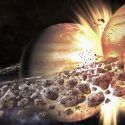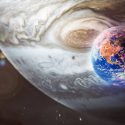Imagine looking up into the night sky and seeing not one but 79 different moons beaming back at you. What would this new night sky look like? How would this affect the Earth’s tides? And how soon would this beautiful sight bring disaster?
Jupiter is the biggest planet in our Solar System. With 79 moons, it falls just behind Saturn’s moon count of 82. And these moons come in different sizes. The teeny-tiny S/2010 J2 is 2 km (1.2 mi) wide, while the massive Ganymede is one and a half times the size of our Moon.
Jupiter’s enormous gravitational pull is to blame for keeping so many moons in its orbit. At 778 million km (484 million mi) from the Sun, it’s not losing any moons in a gravitational tug of war. Now, imagine all those moons moved to Earth. With so many cluttered objects in our orbit, would they all collide and rain debris down on Earth?
With 79 more moons, the night sky would look busier. But since most of the new moons in our orbit would be less than 10 km (6 mi) wide, they’d appear more like bright stars at first glance. But you’d also have the awesome view of four giant moons beaming right back at you. Those would be Io, Europa, Ganymede and Callisto.
Of these, Europa would be the moon that looks the most familiar. It’s about 90% the size of our Moon. But there would be at least one big difference. Europa is covered in ice. That means it would reflect about five and a half times more sunlight than our Moon. You’d be wise to wear sunglasses if you wanted to admire it, even at night.
The most dramatic effects of having Jupiter’s moons would come from Ganymede. While it may be only one and a half times the size of our Moon, it has double its mass. With more of its own gravitational pull, it would have a significant impact on our tides. Get ready for massive tsunamis, extreme earthquakes and more volcanic activity.
Earth’s tides would be higher too. Coastal cities would be flooded and abandoned. In the U.S., where 40% of the population lives near the coast, 127 million people would be displaced. And so would billions more around the world.
Ganymede’s gravitational pull could even be strong enough that the Earth would become tidally locked to it. This would mean that one side of the planet would always be facing this moon. This would be good news if you were on that side of the planet. Hopefully, you made some investments in hotel property with a good view of Ganymede. Moon tourism would be about to boom.
You’d also notice that Earth’s climate was more stable if Ganymede began orbiting us. That’s because a larger moon would stabilize the angle of Earth’s rotation on its axis. Usually, Earth’s axis goes back and forth between an angle of 22.1 to 24.5 degrees every 41,000 years. A more stable axis would mean fewer seasonal changes and no more pesky ice ages in the future.
But if Ganymede and all these other moons invaded our night sky, you wouldn’t be able to enjoy the view for very long. You should expect plenty of havoc. For starters, our traditional concept of a month would become obsolete. Months are based around the natural orbital period of our Moon. Maybe you’d have 80 months in the year, one for every moon in the sky.
And not only months, but your entire concept of a day would likely change. With the gravitational pull of all these moons, the Earth’s rotation would change. With the gravitational pull of our current Moon, the Earth’s rotation is expected to slow down to a 30-hour day in billions of years. With all that light from the Sun reflecting off of each moon, you’d have to get used to a very bright night sky. I hope you aren’t a light sleeper.
The most chaotic aspect of having so many new moons would be their overlapping orbital patterns. Many of the satellites currently in orbit would be at risk of destruction if they collided with a moon. It could jeopardize future space missions too. Earth’s orbit would be dangerously clustered.
That could mean that the Earth might end up with rings, similar to what Saturn has. But it could be that the Earth does not have a strong enough gravitational pull to hold all 80 moons in place. Those moons would be so close to the Sun that the Sun’s gravity could win them over. That could put a few moons on a collision course with the Earth. With all that potential chaos orbiting Earth, you’d probably wish that there weren’t any moons at all.
Sources
- “How strong is the gravity on Jupiter?”. 2021. coolcosmos.ipac.caltech.edu.
- “ESA Science & Technology – Jupiter’s Largest Moons”. 2021. sci.esa.int.
- “Jupiter’s Smallest Known Moon Unveiled”. 2012. space.com.
- “Ganymede: Facts About Jupiter’s Largest Moon”. 2016. space.com.
- “Europa”. 2021. solarsystem.nasa.gov.


























